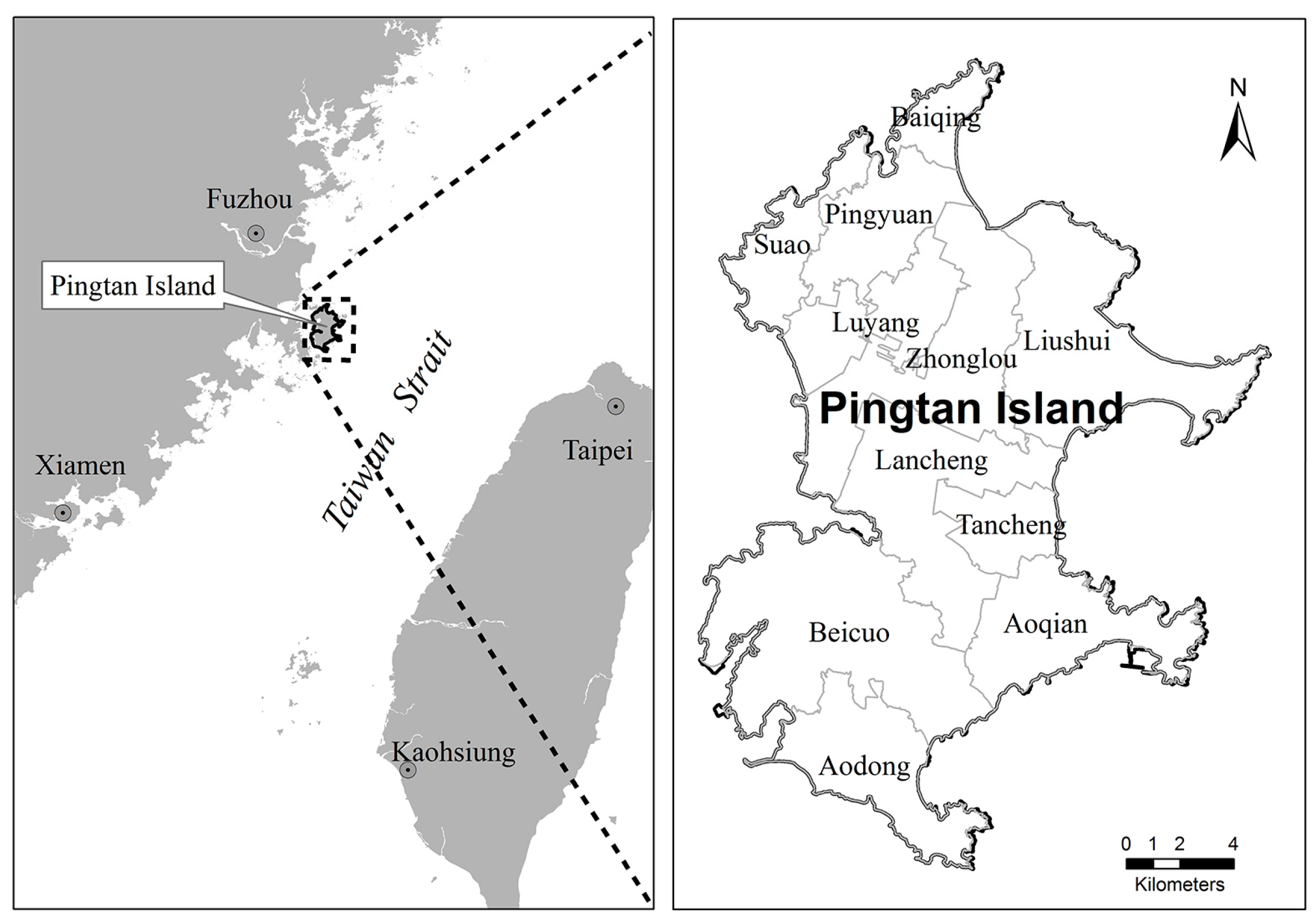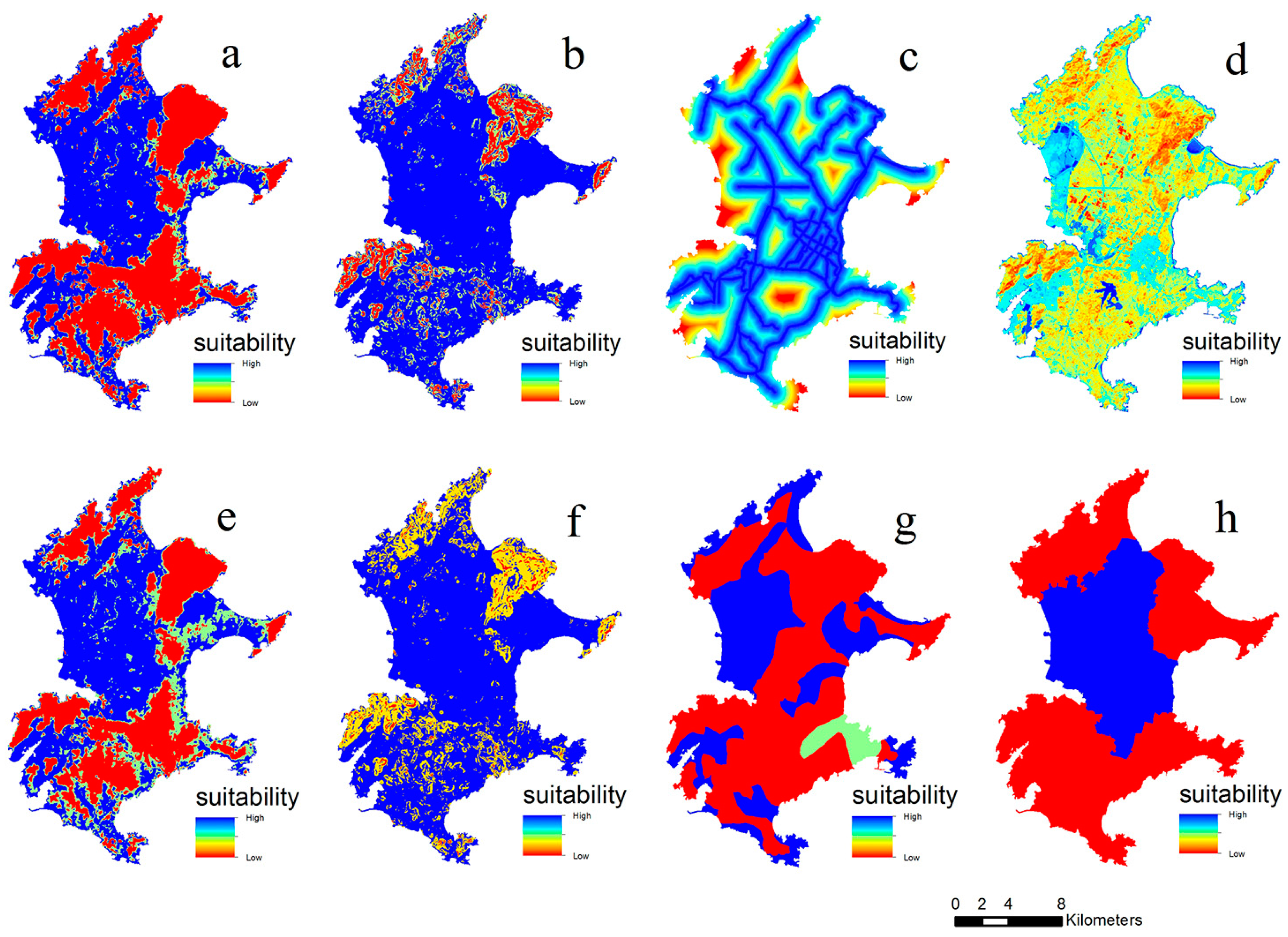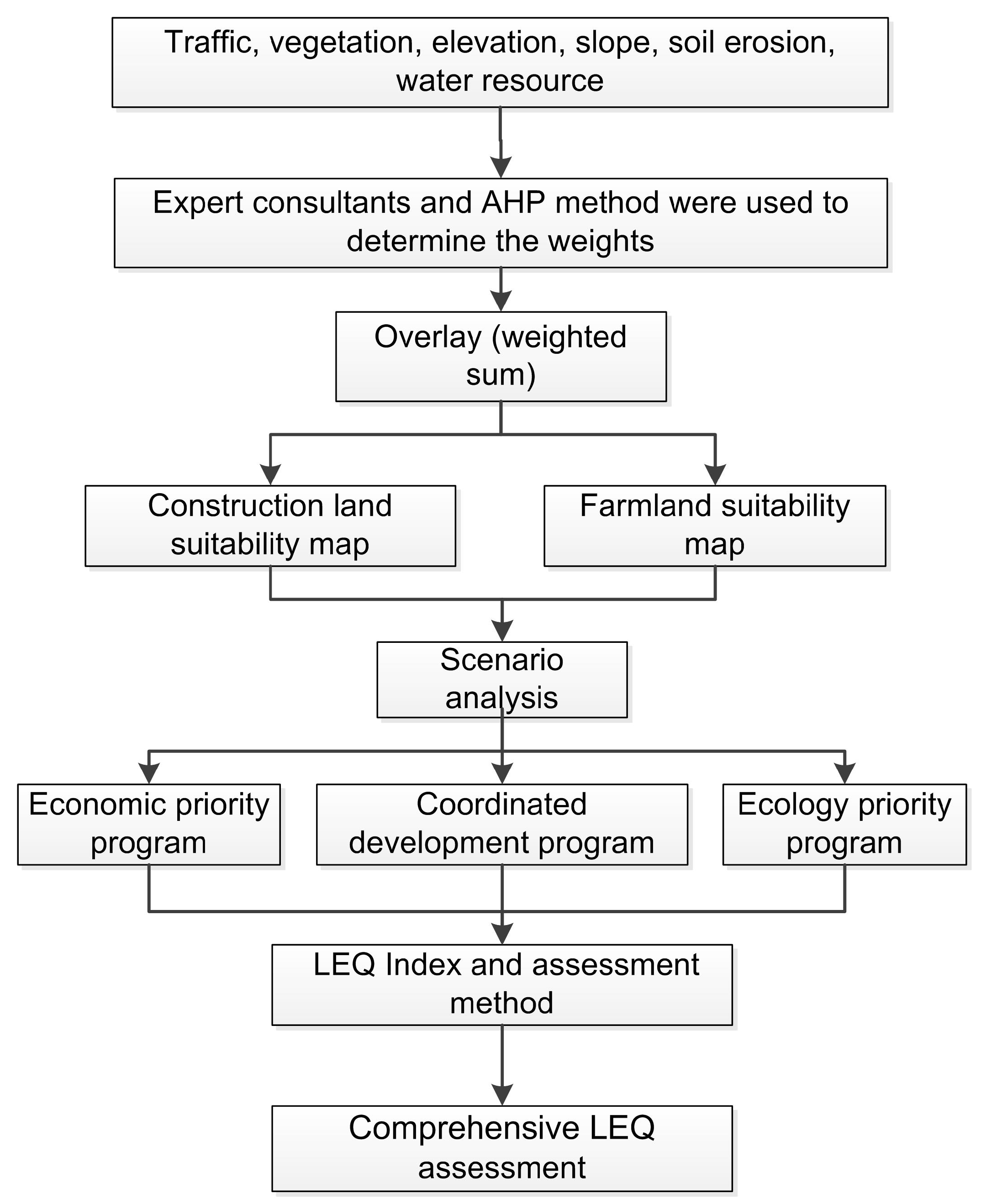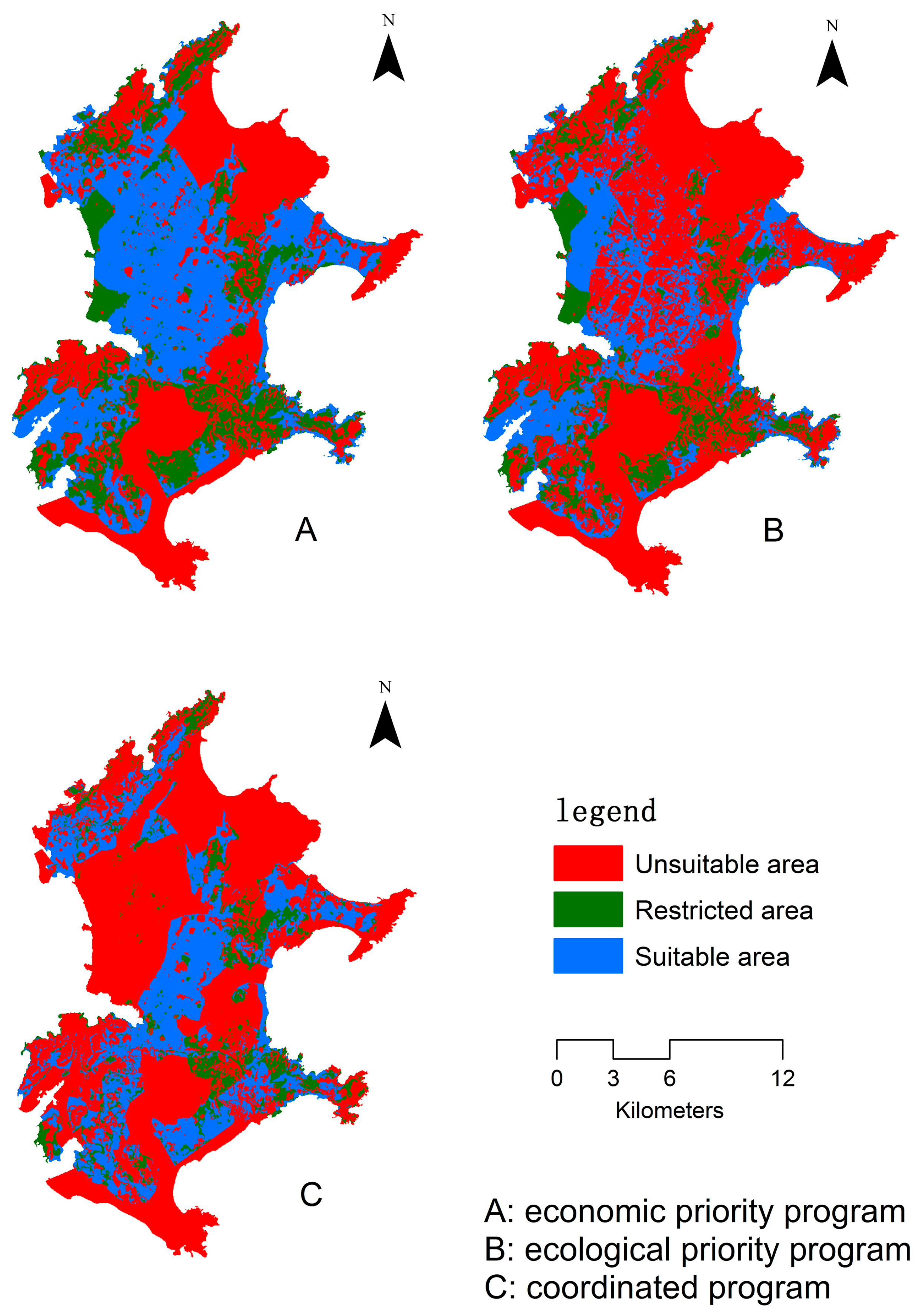2.2.1. Factors Used in the Land Suitability Analysis
To determine whether the land that has not been developed for construction or farming is suitable for these purposes, the factors of elevation, slope, traffic condition, vegetation, soil erosion, and water resource were used (
Table 1). The main reasons for using these factors in this study were that the spatial data concerning the factors used had already been made available for use and the factors used in the study are adequate for determining the areas where agricultural production or urban construction can be carried out. The factors used in this study are explained in detail in the following sections.
Elevation is an important factor that plays a role in the variation of plant cover by causing water resource and soil changes. The higher the elevation, the less water there is [
38]. It is difficult to store rainwater or utilize groundwater on the hills of PI. Field surfaces on hills are full of stone, which is difficult for agriculture or construction, while in the plains, the soil is suitable for agriculture. In most places with high elevation, transportation is inconvenient, which is also unsuitable for construction.
Slope limits agricultural production by affecting soil properties. The thickness of the soil layer decreases with increasing slope. Slope degree is the main factor determining erosion control [
39,
40]. Accordingly, with an increase in slope degree, the development of soils occurs slowly, and soil depth and fertility decrease. Slope negatively affects urban construction by restricting the possibility of using machines and human activity. On the other hand, urban construction will create more bare land, the erosion of which will increase with the increase of the slope degree.
Traffic conditions represent a spatial association between new construction land and existing urban land. The distance to roads increases with decreasing connection and convenience. Traffic conditions have also been used in many other studies [
41,
42,
43].
Vegetation is important for ecosystem stability, and a high vegetation index represents high biomass and biodiversity, so the development cost is increased with increasing vegetation. The normalized difference vegetation index (NDVI) has a long history of use in remote sensing, ecology, and geography to study vegetation characteristics including amount, type, and condition [
44,
45,
46]. The NDVI is a reflection of the biophysical conditions of island vegetation cover. We explored NDVI from Landsat Thematic Mapper (TM) satellite imagery.
Soil erosion reduces the soil depth, which is necessary for the development of plant roots and the amount of water that the plants need, decreasing the content of nutritional elements and organic matter [
47,
48]. Erosion is connected with soil properties. The suitability of the soil for agriculture decreases with the increasing erosion modulus.
Water resource is another important factor for agriculture. Water is the foundation of agriculture. Agriculture increases pressure on the water supply, so water is the limiting condition for agriculture. The annual average runoff depth was selected to represent water resource in our study.
2.2.2. AHP Method
AHP is a multi-criteria decision-making approach introduced by Saaty [
49,
50] which enables users to determine the weights of the factors in the solution of a multi-criteria problem. In the AHP method, a hierarchical model consisting of objectives, criteria, sub-criteria, and alternatives is used for every problem [
51]. After the problem is set on a hierarchical structure, the weights of the criteria forming the hierarchy are calculated. To evaluate the criteria included in a level compared with other criteria included in the next hierarchy level, scoring is made with the utilization of the preference scale (
Table 2) [
52], and a pairwise comparison matrix was created to compare one factor with another [
52,
53].
The AHP approach involves the following five steps: (1) developing an AHP decision model tree; (2) determining the relative importance of a factor to other factors in the judgment matrix; (3) conducting a consistency validation of the judgment matrix forms; (4) calculating the relative importance of each factor and weighting the overall ratings of every layer; and (5) giving a score to each factor based on the score index system. The maximum of the eigenvalue and its eigenvector should be calculated and verified by the coherence ratio (CR). The CR value should be less than 0.10, otherwise the matrix must be adjusted once again [
10,
52,
54]. The pairwise comparison matrix was created to determine the weights of factors (
Table 3 and
Table 4). The relative importance of a factor to other factors was determined by consulting the opinions of a team of experts, including local residents, officials, and experts engaging in geography, oceanography, and ecological research.
2.2.3. Scenario Analysis (SA)
In addition to the basic suitability evaluation factors, factors that affect the island land security should be considered in order to protect the ecological security and construction land of the island. In our study, we took scenic areas and protected areas as ecologically sensitive areas. After construction land and farmland suitability evaluation, we proposed three different land suitability evaluation programs of the island based on different development goals, which are as follows:
(1) Economic priority program
This program focuses on economic development. The program is based on a construction land suitability evaluation, taking existing construction land and ecologically sensitive areas as the unsuitable zone.
(2) Ecological priority program
This program focuses on ecological protection. The program is based on construction land suitability evaluation, taking existing construction land, ecologically sensitive areas, and farmland as the unsuitable zone.
(3) Coordinated development program
Without prejudice to the island’s ecological security, this program can meet the demand for the city’s construction as much as possible. Thus, after deducting the ecologically sensitive areas and existing construction land, we put forward the principle of coordinated development [
55,
56], as shown in
Table 5. In the principle of coordinated development, when the land is suitable for agriculture, it is unsuitable for development, because farmland needs protection. When the land is unsuitable for construction, it is also unsuitable for development. When the land is suitable or restrictive for construction and unsuitable for agriculture, it is suitable for development. When the land is suitable for construction and restrictive for agriculture, it is suitable for development. When the land is restrictive for construction agriculture, it is restrictive for development.
2.2.4. LEQ Evaluation Method
(1) LEQ evaluation
LEQ refers to the ability of a landscape’s ecosystem to maintain its structure and functional stability, taking landscape ecosystem stability as a measure. The stability of LEQ depends on the degree of stability and disturbance of the landscape ecosystem. If the disturbance level of LEQ is greater than the stability, the landscape ecosystem tends toward being unsteady, and LEQ is low; Otherwise, the landscape ecosystem is stable, and LEQ is high [
57].
In this study, the Equation (1) was used to evaluate LEQ, which is shown as follows:
where
V represents LEQ,
Vg is the landscape disturbance index, and
Vw is the landscape stability index. The higher the
V value, the higher the LEQ. Landscape disturbance index and landscape stability index will be described below.
(2) Landscape disturbance index and landscape stability index
The landscape disturbance is affected by landscape fragmentation and land use activities. Landscape fragmentation is a major cause of biodiversity loss, and human activities block the migration of biology and flow of material and energy [
30,
57]. In our study, the landscape shape index (LSI), patch density (PD), and the ratio of construction land (CI) were selected to characterize the landscape disturbance [
57,
58,
59,
60,
61]. LSI is used to indicate the development of patches and the complexity of patch borders. Higher LSI value indicates higher degree of landscape fragmentation, which is related to higher landscape disturbance. PD refers to the fragmentation of the landscape, indicating human disturbance intensity [
62]. Higher PD value means higher landscape disturbance. CI means the construction area proportion of the total landscape area. Higher CI value indicates higher landscape disturbance. In this study, we assumed that the suitable development area was construction land. We also assumed that LSI, PD, and CI have the same contribution to landscape disturbance.
Landscape stability depends on the structure of land use, biodiversity, and landscape aggregation [
57]. Different land use makes different contributions to landscape stability. Wetlands are the best, woodlands next, followed by arable land and water. Construction land is the worst. In this study, suitability evaluation results were used to represent the land use: we identify unsuitable zones as 3, restrictive zones as 2, and suitable zones as 1 quantitatively. Land use contributions to landscape stability were multiplied by the proportion of land use, then weighted to the land use structure index (LS). Higher LS value means higher landscape stability. The vegetation index (VI) is an important factor that affects landscape ecological stability, characterized by the ratio of the area that is covered by vegetation. Higher VI indicates higher landscape stability. In this study, we assumed that unsuitable zone was completely covered by vegetation, half of the restricted area was covered by vegetation, and the suitable zone was uncovered. Optimized landscape patterns are helpful for landscape stability [
57], and the landscape contagion index (CONT) was selected to describe the agglomeration of different types of patches. Higher CONT value means higher landscape stability. We assumed that LS, VI, and CONT have the same contribution to landscape stability.
Landscape disturbance index is evaluated by LSI, PD, and CI. The Equation (2) is as follows:
where
Vg is the landscape disturbance index,
x1 is the LSI,
x2 is the PD,
x3 is the CI.
Landscape stability index is evaluated by LS, CONT, and VI. The Equation (3) is as follows:
where
Vw is the landscape stability index,
x4 is the LS,
x5 is the VI,
x6 is the CONT.
The indices
x1 to
x6 are described in
Table 6. All the indices should be standardized, and all these values ranged from 0 to 1.
2.2.5. Data Sets and Methodology
The slope and elevation data were obtained from the GRID digital elevation model (DEM, CNIC, Beijing, China) of the study area, and the DEM was downloaded from Geospatial Data Cloud [
58]. The cell size of slope and elevation map was 30 × 30 m.
The 30 × 30 m cell size ESRI GRID (ESRI, Redlands, CA, USA) format NDVI map (vegetation index) of the study area were generated from the Landsat Thematic Mapper (USGS, Reston, VA, USA) satellite imagery of 2013 with 30 m resolution. Twenty-one ground control points were used, and the root mean square errors were less than 0.5 pixels. The image was re-sampled to 30 m resolution.
The main road map of 2010 was digitized from 1/200,000 printed map obtained from the Traffic Bureau of Pingtan. The 30 × 30 m cell size ESRI GRID format traffic index map of the study area was generated from ESRI Shape format road map by using the Euclidean distance normalization method.
The ESRI Shape format soil erosion map of 2013 was digitized from 1/200,000 printed map obtained from the Land and Resources Bureau of Pingtan, and the ESRI Shape format water resource index map was digitized from the water resource map in Pingtan water resources allocation planning report [
59]. The ESRI Shape format maps were converted into ESRI GRID format maps with 30 m resolution.
All GIS layers were transformed into the same coordinate system and projection; that is, the projection is Transverse Mercator, the central meridian is 120° E, and the Ellipsoid is WGS 1984. The cell size of ESRI GRID format layers were 30 × 30 m. All the indices were standardized to a uniform rating scale. The class boundaries and standardized measurements are given in
Table 1, and the spatial pattern maps are shown in
Figure 2.
After the weights of factors were determined according to the AHP method, factors weights and factors scores were appointed to the related layers in the ArcGIS 10.1 environment, raster maps of eight factors were overlaid using the weighted sum overlay analysis, and a construction land suitability map and a farmland suitability map were generated. The analysis layers (construction land suitability map and farmland suitability map) were divided into three classes according to natural breaks in the ArcGIS 10.1 environment. The highest score area was identified as suitable area, which was followed by restrictive area. The lowest score area was identified as unsuitable area.
The land suitability map of the economic priority program was obtained by identifying existing construction land and ecologically sensitive areas as the unsuitable zone based on the construction land suitability map. The land suitability map of the ecological priority program was obtained by identifying existing construction land, ecologically sensitive areas, and farmland as the unsuitable zone based on the construction land suitability map. The land suitability map of coordinated development program was obtained according to the principle shown in
Table 5 based on the construction land suitability map and farmland suitability map. Then, the ecologically sensitive areas and existing construction land were taken as the unsuitable zone. The above processes were implemented in the arcGIS 10.1 environment by raster calculation and reassignment.
The six indices in the LEQ evaluation (LSI, PD, CI, LS, VI, and CONT) were calculated by Fragstats 4.2 (UMASS, Amherst, USA) based on land suitability map for three scenarios. Then, we calculated the landscape disturbance index, landscape stability index, and LEQ index according to Equations (2), (3), and (1), respectively. The steps followed in this study are presented in general terms in
Figure 3.









